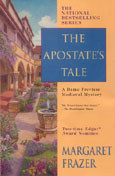The story goes thusly: Margaret of Antioch was a beautiful virgin who became a Christian in the days when persecuting Christians was fashionable among the Romans. For repelling the advances of a Roman official, she was arrested and put to many torments. During this time she was cast into a dungeon where the Devil himself came to persecute her. It is said he appeared as a dragon and finally, annoyed at her refusal to be terrified, he swallowed her whole. Then, either because she was holding a cross or made the sign of the cross, the dragon’s body split open and Margaret emerged unharmed.
Of course she was eventually martyred — by beheading in her case — and became a saint and – of all things — the patron of women in childbirth. (The way that, say, St. Laurence who was martyred on a grill over a fire is the patron saint of cooks; or St. Apollonia who was battered with stones and had her teeth knocked out is the patron saint of dentists.)
St. Margaret often appears in medieval art. If your see a graceful young woman portrayed with a dragon — sometimes emerging from his belly, sometimes leading him by a collar around his neck and a chain – that will probably be St. Margaret.
But I am not sharing her story out of piety. My real purpose is to share this picture:

To share this picture and show the sort of wicked humor medieval people were comfortable with in their religion and because every time I see it — the look on the dragon’s face, with his “victim’s” skirt still trailing out of the his mouth as she rises out of his stomach – I laugh out loud.
But more than just the humor, this illustrates another of the reasons that I can never stop researching. If I hadn’t studied saints as a way to better understand the medieval world view, I wouldn’t know St. Margaret of Antioch’s story, and this picture would be simply something to frown over in blank puzzlement at what it was all about. The medieval world is not ours, and if we don’t know what we’re looking at in their context, much of the richness of the medieval world escapes us. Pictures and other artwork were often layered with meanings no longer readily grasped but understood almost automatically in medieval times.
Decades ago I stood on the green before the west front of Wells Cathedral, able to do little more that say, “Wow. Look at all those statues.” A few years ago I stood there again and found myself automatically starting to “read” that west front like some giant book. After all my years of research, trying to learn to “think medievally”, the iconography that went with each statue and even where they were positioned on the cathedral’s front were layered with meanings for me. It was a vastly exciting experience, not least because I hadn’t come there intending to read it. Without thinking about it, I simply, automatically, started to, just as a medieval person would have.
Which I suppose explains a lot about my occasional disorientation with the 21st century?
– Margaret


















